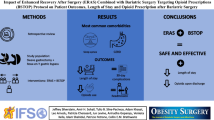Abstract
Introduction
There has been a recent increased interest in the use of non-steroidal anti-inflammatory drugs (NSAIDs) such as ketorolac for post-operative pain management to minimize opioid use and decrease hospital length of stay (LOS). Although NSAID use has been controversial following bariatric surgery due to anecdotal concerns for increased gastric bleeding, the impact of ketorolac as an adjunct to opioids needs further investigation on LOS and post-operative complications like bleeding.
Objective
This study aims to evaluate the impact of post-operative ketorolac use on opioid consumption, LOS, and bleeding risk after bariatric surgery.
Methods
We retrospectively analyzed a prospectively maintained database of all bariatric surgery patients who either underwent sleeve gastrectomy (SG) or Roux-en-Y gastric bypass surgery (RYGB) at a tertiary center between 2011 and 2015. Patients were stratified into 2 groups based on post-operative pain control regimen as follows: (1) ketorolac and opioids and (2) opioids alone.
Results
A total of 1555 patients were identified who underwent either SG (n = 1255) or RYGB (n = 300). The overall LOS was 1.81 ± .059 days for ketorolac-opioid patients vs. 2.09 ± .065 days for opioid-only patients (P < 0.001). Furthermore, the risk of post-operative bleeding was similar between the two groups (P = 0.097).
Conclusion
Patients who received ketorolac as an adjunct to opioids had a significantly shorter LOS compared to opioid-only patients. Additionally, ketorolac use was not associated with increased risk of post-operative bleeding complications. Therefore, if not contraindicated, ketorolac should be considered routinely for post-operative pain control among bariatric surgery patients.

Similar content being viewed by others
References
Stephan BC, Parsa FD. Avoiding opioids and their harmful side effects in the postoperative patient: exogenous opioids, endogenous endorphins, wellness, mood, and their relation to postoperative pain. Hawaii J Med Public Health. 2016;75(3):63–7.
Benyamin R, Trescot AM, Datta S, et al. Opioid complications and side effects. Pain Physician. 2008;11(2 Suppl):S105–20.
Marret E, Kurdi O, Zufferey P, et al. Effects of nonsteroidal antiinflammatory drugs on patient-controlled analgesia morphine side effects: meta-analysis of randomized controlled trials. Anesthesiology. 2005;102(6):1249–60.
Eberson CP, Pacicca DM, Ehrlich MG. The role of ketorolac in decreasing length of stay and narcotic complications in the postoperative pediatric orthopaedic patient. J Pediatr Orthop. 1999;19(5):688–92.
Garimella V, Cellini C. Postoperative pain control. Clin Colon Rectal Surg. 2013;26(3):191–6.
Munro HM, Walton SR, Malviya S, et al. Low-dose ketorolac improves analgesia and reduces morphine requirements following posterior spinal fusion in adolescents. Can J Anaesth. 2002;49(5):461–6.
Etches RC, Warriner CB, Badner N, et al. Continuous intravenous administration of ketorolac reduces pain and morphine consumption after total hip or knee arthroplasty. Anesth Analg. 1995;81(6):1175–80.
Lowder JL, Shackelford DP, Holbert D, et al. A randomized, controlled trial to compare ketorolac tromethamine versus placebo after cesarean section to reduce pain and narcotic usage. Am J Obstet Gynecol. 2003;189(6):1559–62.
Stephens DM, Richards BG, Schleicher WF, et al. Is ketorolac safe to use in plastic surgery? A critical review. Aesthet Surg J. 2015;35(4):462–6.
Cassinelli EH, Dean CL, Garcia RM, et al. Ketorolac use for postoperative pain management following lumbar decompression surgery: a prospective, randomized, double-blinded, placebo-controlled trial. Spine. 2008;33(12):1313–7.
Power I, Noble DW, Douglas E, et al. Comparison of i.m. ketorolac trometamol and morphine sulphate for pain relief after cholecystectomy. Br J Anaesth. 1990;65(4):448–55.
Jelinek GA. Ketorolac versus morphine for severe pain. BMJ. 2000;321(7271):1236–7.
Forrest JB, Camu F, Greer IA, et al. Ketorolac, diclofenac, and ketoprofen are equally safe for pain relief after major surgery. Br J Anaesth. 2002;88(2):227–33.
Stouten EM, Armbruster S, Houmes RJ, et al. Comparison of ketorolac and morphine for postoperative pain after major surgery. Acta Anaesthesiol Scand. 1992;36(7):716–21.
Richardson MD, Palmeri NO, Williams SA, et al. Routine perioperative ketorolac administration is not associated with hemorrhage in pediatric neurosurgery patients. J Neurosurg Pediatr. 2016;17(1):107–15.
Hassan M, Tuckman HP, Patrick RH, et al. Hospital length of stay and probability of acquiring infection. Intl J Pharm Health Mrkt. 2010;4(4):324–38.
Feldheiser A, Aziz O, Baldini G, et al. Enhanced Recovery After Surgery (ERAS) for gastrointestinal surgery, part 2: consensus statement for anaesthesia practice. Acta Anaesthesiol Scand. 2016;60(3):289–334.
Carmichael JC, Keller DS, Baldini G, et al. Clinical practice guidelines for enhanced recovery after Colon and Rectal surgery from the American Society of Colon and Rectal Surgeons and Society of American Gastrointestinal and Endoscopic Surgeons. Dis Colon Rectum. 2017;60(8):761–84.
Soffin EM, YaDeau JT. Enhanced recovery after surgery for primary hip and knee arthroplasty: a review of the evidence. Br J Anaesth. 2016;117(suppl_3):iii62–72.
Govindarajan R, Ghosh B, Sathyamoorthy MK, et al. Efficacy of ketorolac in lieu of narcotics in the operative management of laparoscopic surgery for morbid obesity. Surg Obes Relat Dis. 2005;1(6):530–5.
Strom BL, Berlin JA, Kinman JL, et al. Parenteral ketorolac and risk of gastrointestinal and operative site bleeding: a Postmarketing surveillance study. JAMA. 1996;275(5):376–82.
Gobble RM, Hoang HLT, Kachniarz B, et al. Ketorolac does not increase perioperative bleeding: a meta-analysis of randomized controlled trials. Plast Reconstr Surg. 2014;133(3):741–55.
Greer IA. Effects of ketorolac tromethamine on hemostasis. Pharmacotherapy. 1990;10(6 ( Pt 2)):71S–6S.
Author information
Authors and Affiliations
Corresponding author
Ethics declarations
All procedures performed in studies involving human participants were in accordance with the ethical standards of the institutional and/or national research committee and with the 1964 Helsinki declaration and its later amendments or comparable ethical standards. For this type of study formal consent is not required.
Conflict of Interest
The authors declare that they have no conflict of interest.
Informed Consent
Informed consent was obtained from all individual participants included in the study.
Additional information
Publisher’s Note
Springer Nature remains neutral with regard to jurisdictional claims in published maps and institutional affiliations.
Rights and permissions
About this article
Cite this article
Hariri, K., Hechenbleikner, E., Dong, M. et al. Ketorolac Use Shortens Hospital Length of Stay After Bariatric Surgery: a Single-Center 5-Year Experience. OBES SURG 29, 2360–2366 (2019). https://doi.org/10.1007/s11695-018-03636-z
Published:
Issue Date:
DOI: https://doi.org/10.1007/s11695-018-03636-z




